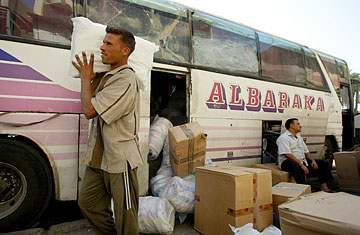
A worker unloads cardboard boxes from a bus carrying returning Iraqi refugees at Baghdad's international bus station, Nov. 9, 2007
Ali Hussein Alwan was born in Baghdad's Rahmaniyah neighborhood in 1934. He had lived there for more than 70 years when members of al-Qaeda in Iraq (AQI) began a campaign of intimidation against Shi'ites and uncooperative Sunnis.
With gunmen roaming the streets of the neighborhood, killing and torturing its residents, Alwan abandoned his shop and his home and took shelter at his brother's house in another part of Baghdad.
"I made the decision to leave before I lost any of my family," he told an Iraqi reporter working for TIME.
Now, though, he is back in Rahmaniyah — joining other residents who fled violence and intimidation but have now returned to the neighborhood. Rahmaniyah is one of several areas of Baghdad that have seen a return of refugees as violence has declined in the past two months. But Baghdad remains violent and unstable. The question now is whether improvements in some neighborhoods can be sustained, and expanded into national progress.
"Many returnees do not feel like their security is guaranteed at this point," said Dana Graber Ladek, who tracks displaced Iraqis for the International Organization for Migration. "Until security is assured, we will not see the return of the millions of people who have been displaced within the country and to the surrounding region."
That uncertainty is reflected in the seemingly contradictory reports this month on Iraqi refugees. A few days after the Iraqi government announced that more than 40,000 refugees were returning home from abroad, the Iraqi Red Crescent, one of the few humanitarian aid organizations with a large-scale presence in Iraq, reported an increase in the number of Iraqis fleeing their homes for other parts of the country.
"The number of Iraqis being displaced still far exceeds the number of Iraqis returning," Ladek said. But she noted that fewer people have been fleeing their homes in the past few months, especially in Baghdad. The situation varies by neighborhood; some remain exceptionally dangerous, while others have improved.
With the national picture uncertain, Baghdad residents are making decisions on a neighborhood-by-neighborhood basis. Those who had fled Rahmaniyah watched for news reports and stayed in touch with friends and relatives who remained in the area. Alwan, though, wanted a firsthand look.
"I took it step by step," he said. "I used to come to the area and have a look from the outskirts. I started seeing people coming out into the streets. I decided I should be one of the earliest to get back."
He returned to a neighborhood dramatically safer, for now, than the one he left. Some residents cited the increased presence of Americans and an increase in the number of Iraqi Army checkpoints. But a more decisive influence may be groups of Sunni fighters who decided that AQI was a greater threat than the Shi'ite government — similar to what took place in heavily Sunni Anbar province earlier this year. In Rahmaniyah residents spoke of "good people from the neighborhood" who fought to push AQI out of the area.
That reliance on armed neighborhood residents, rather than national security forces, points to possible limits on the recent progress. In western Baghdad's Ghazaliyah neighborhood, as in Rahmaniyah, some Sunnis are returning home, encouraged by reports of improved safety and the advent of a locally recruited security force. But unless that local progress is backed up by political progress at higher levels, gains in Baghdad's neighborhoods could be swamped by continuing national strife.
Discouragingly, Sunni residents of Ghazaliyah told TIME's Iraqi reporter that, while they trust the local Shi'ite Army units more than they did earlier in the year, they remain wary. The use of Sunni men to defend Sunni enclaves hints at a more grim explanation for the drop in violence: many neighborhoods have completed their brutal sectarian segregation, leaving fewer easy targets for intimidation and murder. What's more, Ghazaliyah residents say recent progress has hinged on the continued presence of American troops, and with that presence set to decline over the next several months, a reality check looms.
Another resident who has returned to Rahmaniyah is a woman who called herself Um Gaith. Her family had been in the area for 50 years before she fled from AQI. Now she's back, once again operating a small shop in the neighborhood, and facing an uncertain future.
"I hope it's going to be stable," she said. "I hope."
